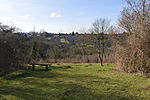High Wycombe Chair Making Museum
Buckinghamshire building and structure stubsChair-makingDecorative arts museums in EnglandFurniture museumsHigh Wycombe ... and 4 more
Industry museums in EnglandMuseums in BuckinghamshireUnited Kingdom museum stubsUse British English from February 2023
The High Wycombe Chair Making Museum in High Wycombe, England, houses a collection of antique tools, and explains the process of how the bodgers worked in the woods through to the finished Windsor chairs. It is now run as a community interest company.
Excerpt from the Wikipedia article High Wycombe Chair Making Museum (License: CC BY-SA 3.0, Authors).High Wycombe Chair Making Museum
Grafton Street,
Geographical coordinates (GPS) Address Nearby Places Show on map
Geographical coordinates (GPS)
| Latitude | Longitude |
|---|---|
| N 51.635 ° | E -0.7733 ° |
Address
Kraftin Village
Grafton Street
HP12 3EX , Castlefield (High Wycombe Community Board, Sands)
England, United Kingdom
Open on Google Maps







